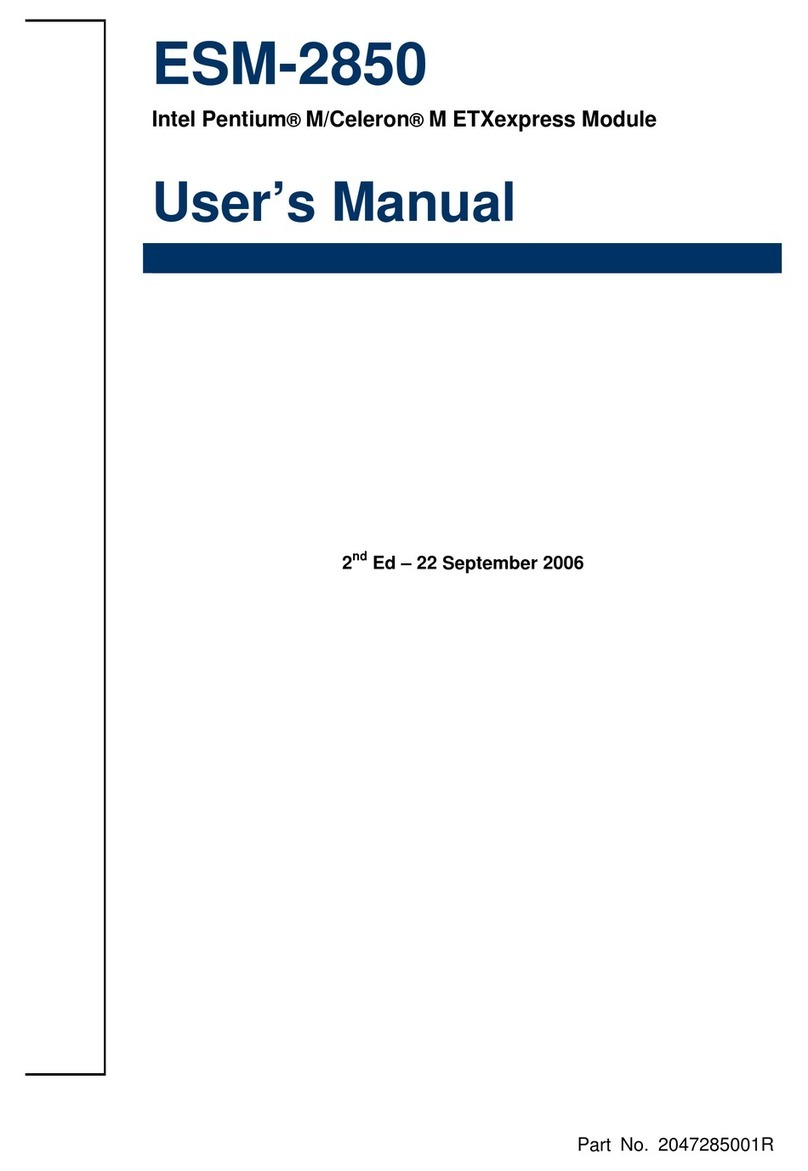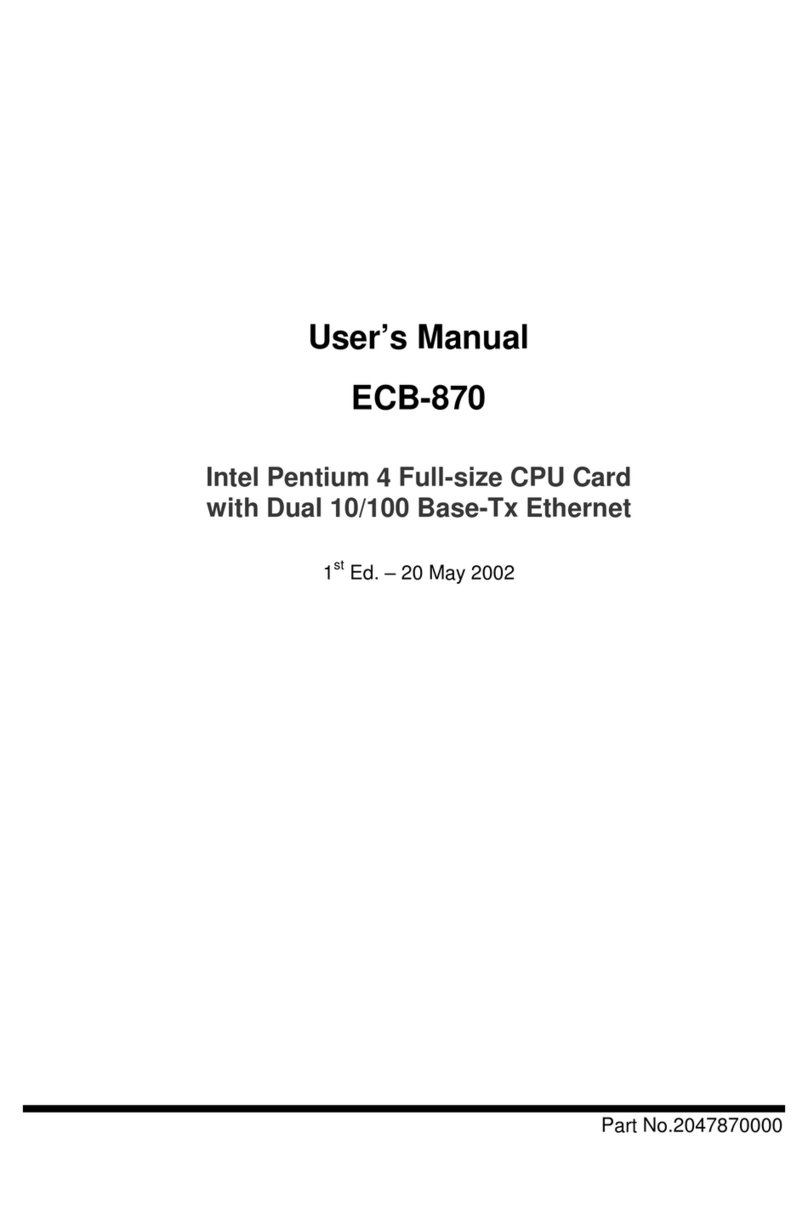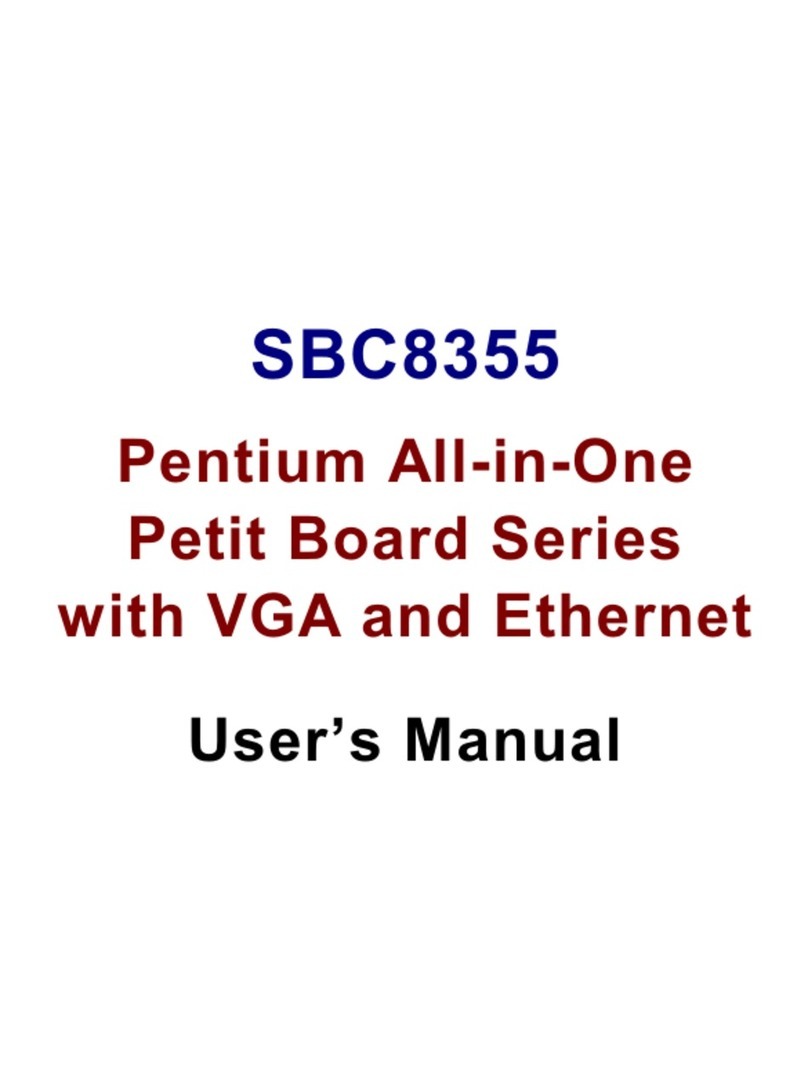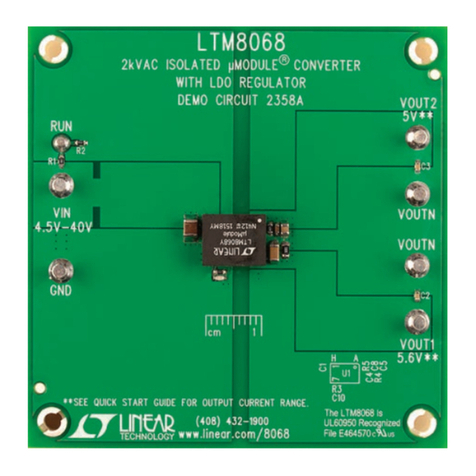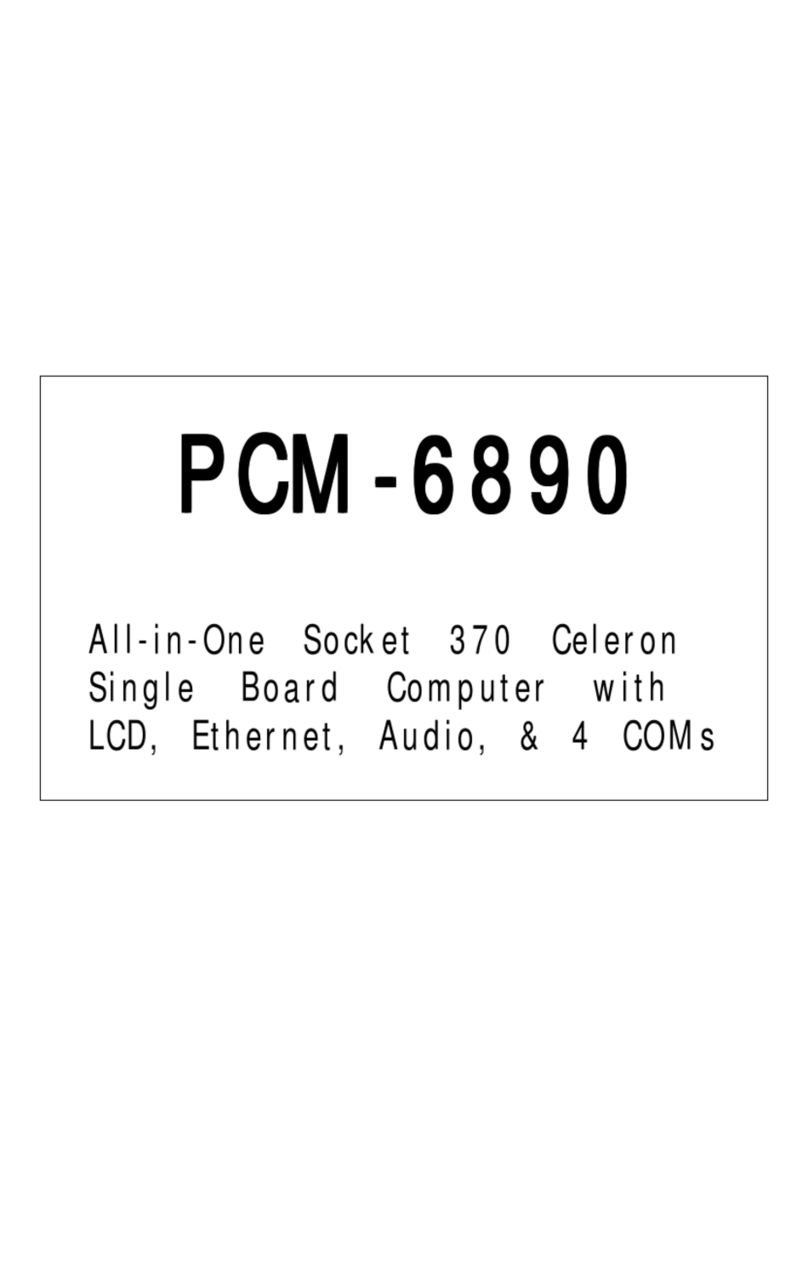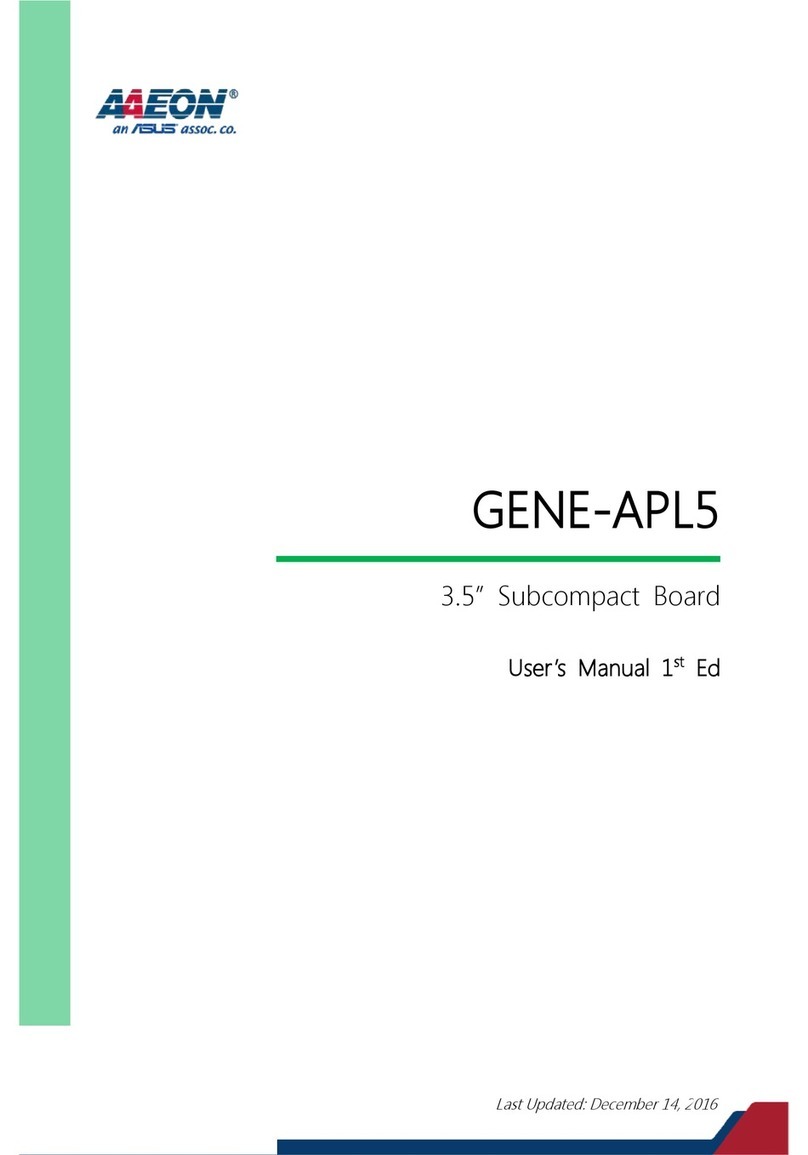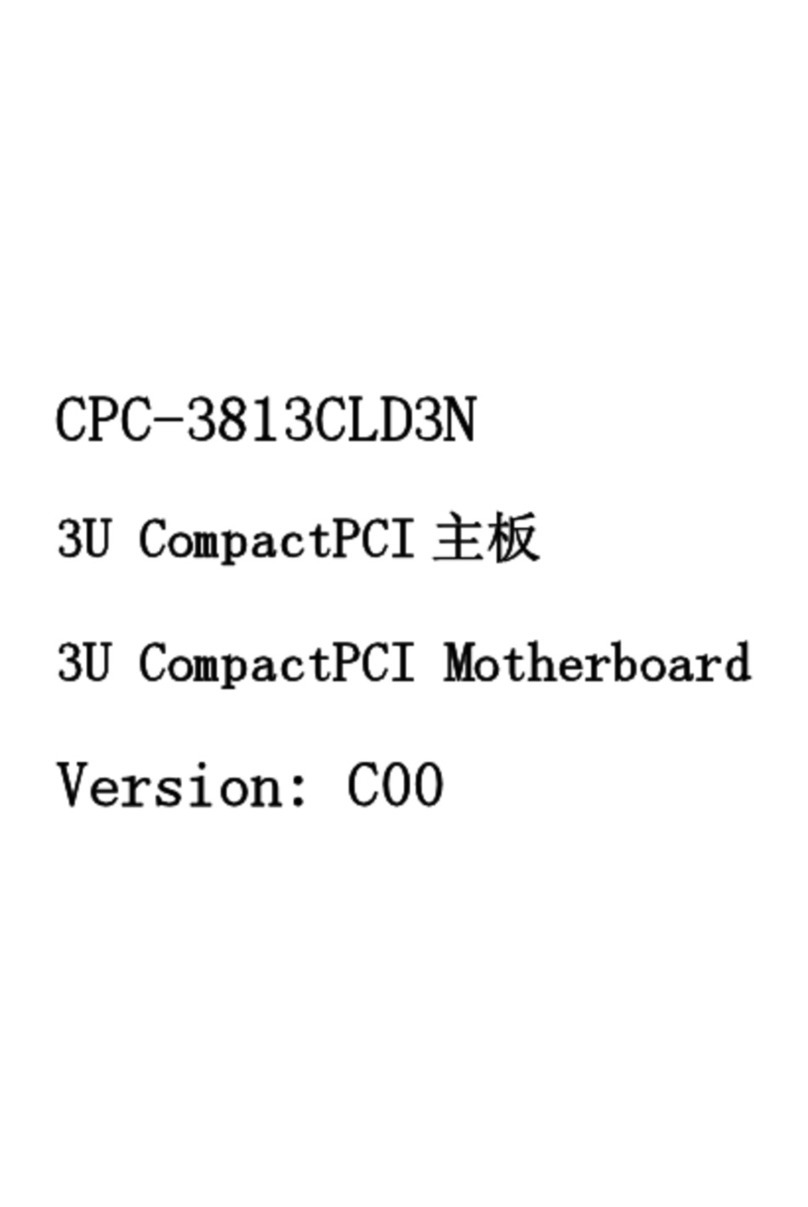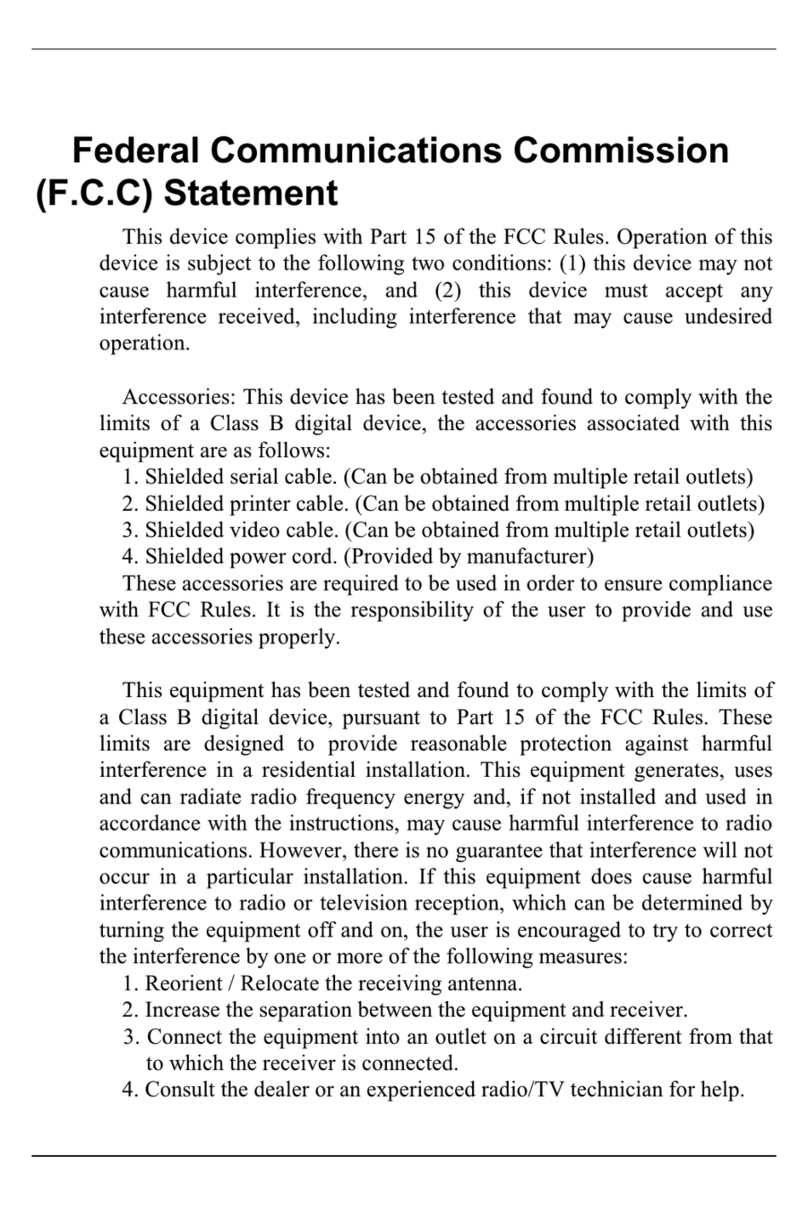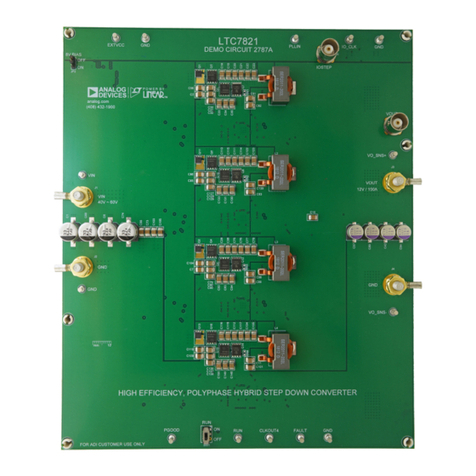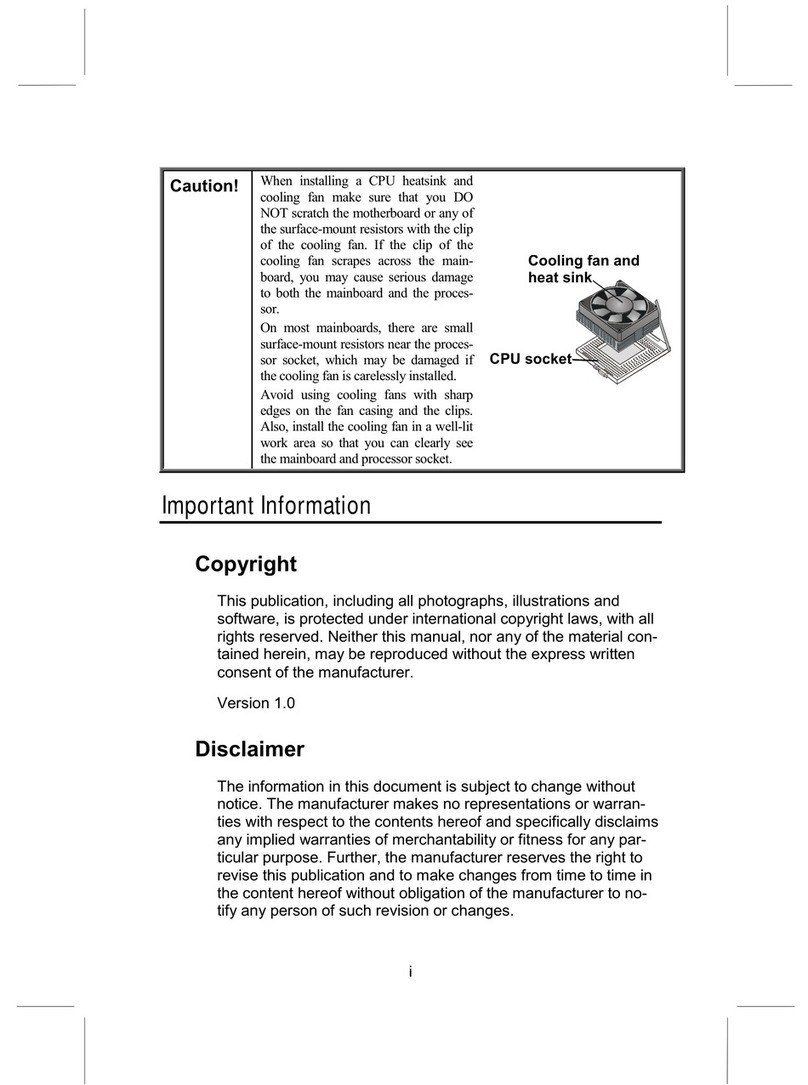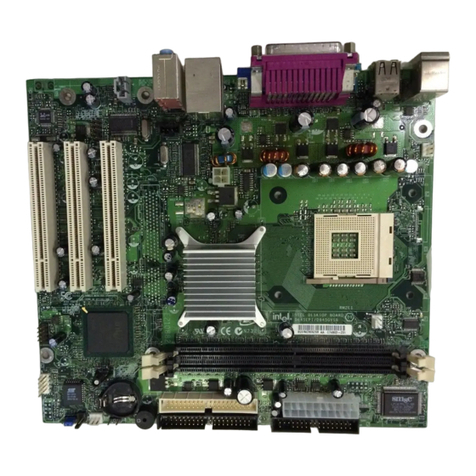Evalue Technology ECM-3610 User manual

Part No. 2047361000
User’s Manual
ECM-3610/3610L
All-in-One VIA Eden ESP6000 Single Board with LCD, LVDS,
AC97 Audio, & Dual 10/100Base-Tx Ethernet
6th Ed. –15 November 2004

ECM-3610/3610L
Evalue Technology Inc.
FCC STATEMENT
THIS DEVICE COMPLIES WITH PART 15 FCC RULES. OPERATION IS SUBJECT TO
THE FOLLOWING TWO CONDITIONS:
(1) THIS DEVICE MAY NOT CAUSE HARMFUL INTERFERENCE.
(2) THIS DEVICE MUST ACCEPT ANY INTERFERENCE
RECEIVED INCLUDING INTERFERENCE THAT MAY CAUSE UNDESIRED
OPERATION.
THIS EQUIPMENT HAS BEEN TESTED AND FOUND TO COMPLY WITH THE LIMITS
FOR A CLASS "A" DIGITAL DEVICE, PURSUANT TO PART 15 OF THE FCC RULES.
THESE LIMITS ARE DESIGNED TO PROVIDE REASONABLE PROTECTION
AGAINTST HARMFUL INTERFERENCE WHEN THE EQUIPMENT IS OPERATED IN A
COMMERCIAL ENVIRONMENT. THIS EQUIPMENT GENERATES, USES, AND CAN
RADIATE RADIO FREQUENCY ENERGY AND, IF NOT INSTATLLED AND USED IN
ACCORDANCE WITH THE INSTRUCTION MANUAL, MAY CAUSE HARMFUL
INTERFERENCE TO RADIO COMMUNICATIONS.
OPERATION OF THIS EQUIPMENT IN A RESIDENTIAL AREA IS LIKELY TO CAUSE
HARMFUL INTERFERENCE IN WHICH CASE THE USER WILL BE REQUIRED TO
CORRECT THE INTERFERENCE AT HIS OWN EXPENSE.

User’s Manual
Evalue Technology Inc.
Copyright Notice
Copyright 2002, 2003, Evalue Technology Inc., ALL RIGHTS RESERVED.
No part of this document may be reproduced, copied, translated, or transmitted in any
form or by any means, electronic or mechanical, for any purpose, without the prior written
permission of the original manufacturer.
Trademark Acknowledgement
Brand and product names are trademarks or registered trademarks of their respective
owners.
Disclaimer
Evalue Technology Inc. reserves the right to make changes, without notice, to any product,
including circuits and/or software described or contained in this manual in order to
improve design and/or performance. Evalue Technology assumes no responsibility or
liability for the use of the described product(s), conveys no license or title under any
patent, copyright, or mask work rights to these products, and makes no representations or
warranties that these products are free from patent, copyright, or mask work right
infringement, unless otherwise specified. Applications that are described in this manual
are for illustration purposes only. Evalue Technology Inc. makes no representation or
warranty that such application will be suitable for the specified use without further testing
or modification.
Life Support Policy
Evalue Technology’s PRODUCTS ARE NOT FOR USE AS CRITICAL COMPONENTS IN
LIFE SUPPORT DEVICES OR SYSTEMS WITHOUT THE PRIOR WRITTEN APPROVAL
OF Evalue Technology Inc.
As used herein:
1. Life support devices or systems are devices or systems which, (a) are intended for
surgical implant into body, or (b) support or sustain life and whose failure to perform,
when properly used in accordance with instructions for use provided in the labelling,
can be reasonably expected to result in significant injury to the user.
2. A critical component is any component of a life support device or system whose failure
to perform can be reasonably expected to cause the failure of the life support device or
system, or to affect its safety or effectiveness.

ECM-3610/3610L
Evalue Technology Inc.
A Message to the Customer
Evalue Customer Services
Each and every Evalue’s product is built to the most exacting specifications to ensure
reliable performance in the harsh and demanding conditions typical of industrial
environments. Whether your new Evalue device is destined for the laboratory or the
factory floor, you can be assured that your product will provide the reliability and ease of
operation for which the name Evalue has come to be known.
Your satisfaction is our primary concern. Here is a guide to Evalue’s customer services.
To ensure you get the full benefit of our services, please follow the instructions below
carefully.

User’s Manual
Evalue Technology Inc.
Technical Support
We want you to get the maximum performance from your products. So if you run into
technical difficulties, we are here to help. For the most frequently asked questions, you
can easily find answers in your product documentation. These answers are normally a lot
more detailed than the ones we can give over the phone. So please consult this manual
first.
To receive the latest version of the user manual, please visit our Web site at:
http://www.evalue-tech.com/
If you still cannot find the answer, gather all the information or questions that apply to your
problem, and with the product close at hand, call your dealer. Our dealers are well trained
and ready to give you the support you need to get the most from your Evalue’s products.
In fact, most problems reported are minor and are able to be easily solved over the phone.
In addition, free technical support is available from Evalue’s engineers every business
day. We are always ready to give advice on application requirements or specific
information on the installation and operation of any of our products. Please do not
hesitate to call or e-mail us.
Headquarters
Evalue Technology Inc.
7F, 228, Lian-Cheng Road,
Chung-ho City, Taipei,
Taiwan
Tel: +886-2-82262345
Fax: +886-2-82262777
http://www.evalue-tech.com
E-mail: service@evalue-tech.com
Europe Branch Office
Evalue Europe A/S
Nordre Strandvej 119C,
3150 Hellebaek,
Denmark
Tel : +45-7025-0310
Fax : +45-4975-5026
http://www.evalue-tech.com
E-mail: service.europe@evalue-tech.com
China Branch Office
Evalue Technology Shanghai Inc.
Room 909, 9F, Section B, No.900,
Yisan Road, Caohejing Hi-tech Park,
Shanghai 200233, China
Tel : +86-21-6470-3454
Fax : +86-21-6470-3454
http://www.evalue-tech.com
E-mail: service.china@evalue-tech.com
US Branch Office
Evalue Technology Inc.
Suite 210, 200 Tornillo Way,
Tinton Falls, NJ 07712
USA
Tel: +732-578-0200
Fax: +732-578-0250
http://www.evalue-tech.com
E-mail: service.usa@evalue-tech.com

ECM-3610/3610L
Evalue Technology Inc.
Product Warranty
Evalue warrants to you, the original purchaser, that each of its products will be free from
defects in materials and workmanship for two yearsfrom the date of purchase.
This warranty does not apply to any products which have been repaired or altered by
persons other than repair personnel authorized by Evalue, or which have been subject to
misuse, abuse, accident or improper installation. Evalue assumes no liability under the
terms of this warranty as a consequence of such events. Because of Evalue’s high
quality-control standards and rigorous testing, most of our customers never need to use
our repair service. If an Evalue’sproduct is defective, it will be repaired or replaced at no
charge during the warranty period. For out-of-warranty repairs, you will be billed
according to the cost of replacement materials, service time, and freight. Please consult
your dealer for more details. If you think you have a defective product, follow these steps:
1. Collect all the information about the problem encountered. (For example, CPU type
and speed, Evalue’sproducts model name, hardware & BIOS revision number, other
hardware and software used, etc.) Note anything abnormal and list any on-screen
messages you get when the problem occurs.
2. Call your dealer and describe the problem. Please have your manual, product, and
any helpful information readily available.
3. If your product is diagnosed as defective, obtain an RMA (return material authorization)
number from your dealer. This allows us to process your good return more quickly.
4. Carefully pack the defective product, a complete Repair and Replacement Order Card
and a photocopy proof of purchase date (such as your sales receipt) in a shippable
container. A product returned without proof of the purchase date is not eligible for
warranty service.
5. Write the RMA number visibly on the outside of the package and ship it prepaid to
your dealer.

User’s Manual
Evalue Technology Inc.
Packing List
Before you begin installing your single board, please make sure that the following
materials have been shipped:
n1 ECM-3610/3610L All-in-One VIA Eden ESP6000 Computing Module
n1 Quick Installation Guide
n1Audio jacks and USB connector daughter board
n1 CD-ROM contains the followings:
—User’s Manual (this manual in PDF file)
—Ethernet driver and utilities
—VGA drivers and utilities
—Audio drivers and utilities
nCable set includes the followings:
—1 PS/2 keyboard and mouse Y cable (6-pin, Mini-DIN)
—1 IDE HDD cable (40-pin, pitch 2.54mm)
—1 FDD cable (34-pin, pitch 2.0mm)
—1 bracket with one printer port cable (26-pin, pitch 2.0mm) and one serial port
cable (10-pin, pitch 2.0mm)
—2 flat cables (10-pin, pitch 2.0mm) for connecting the Audio/USB daughter board
to the ECM-3610
If any of these items are missing or damaged, please contact your distributor or sales
representative immediately.

ECM-3610/3610L
Evalue Technology Inc.
1. MANUAL OBJECTIVES ............................................................................................ 1
2. INTRODUCTION........................................................................................................ 1
2.1 System Overview................................................................................................... 1
2.2 System Specifications.......................................................................................... 2
2.3 Architecture Overview .......................................................................................... 5
2.3.1 VIA Eden™Processor................................................................................................ 6
2.3.2 VIA VT8606 North Bridge............................................................................................ 6
2.3.3 VIA VT82C686B South Bridge.................................................................................. 11
2.3.4 Realtek RTL8139C Ethernet Controller..................................................................... 13
2.3.5 Intel 82559ER Ethernet Controller (Optional)............................................................ 13
2.3.6 Compact Flash Interface........................................................................................... 14
3. HARDWARE CONFIGURATION............................................................................. 15
3.1 Installation Procedure......................................................................................... 15
3.2 Safety Precautions.............................................................................................. 15
3.2.1 Warning! ................................................................................................................... 15
3.2.2 Caution!..................................................................................................................... 15
3.3 Installing DRAM (SODIMMs)............................................................................... 16
3.3.1 System Memory ........................................................................................................ 16
3.3.2 Memory Installation Procedures................................................................................ 16
3.4 Jumper & Connector........................................................................................... 17
3.4.1 Jumper & Connector Layout ..................................................................................... 17
3.5 Jumper and Connector List................................................................................ 18
3.6 Setting Jumpers.................................................................................................. 20
3.6.1 Clear CMOS (J4)....................................................................................................... 20
3.6.2 COM2 RS-232/422/485 Select (J5, J6)..................................................................... 21
3.6.3 AT/ATX Power Select (ATATX1)............................................................................... 21
3.7 Connector Definitions......................................................................................... 22
3.7.1 Pin Header Serial Port 2 Connector in RS-232 Mode (CM1)..................................... 22
3.7.2 Serial Port 2 with External DB9 Connector (CM1)..................................................... 22
3.7.3 Signal Description –Serial Port 2 –COM2 in RS-232 Mode (CM1)......................... 22
3.7.4 Pin Header Serial Port 2 Connector in RS-422 Mode (CM1)..................................... 23
3.7.5 Signal Description –Serial Port 2 –COM2 in RS-422 Mode (CM1)......................... 23
3.7.6 Pin Header Serial Port 2 Connector in RS-485 Mode (CM1)..................................... 23
3.7.7 Signal Description –Serial Port 2 –COM2 in RS-485 Mode (CM1).......................... 24
3.7.8 Serial Port 1 with External DB9 Connector (CM2)..................................................... 24
3.7.9 Signal Description –Serial Port 1 –COM1 in RS-232 Mode (CM2).......................... 25
3.7.10 Secondary LCD Panel Connector (CN1)................................................................... 25
3.7.11 Primary LCD Panel Connector (CN2)........................................................................ 26
3.7.12 Signal Description –Primary & Secondary LCD Panel Connector (CN2, CN1) ........ 26

User’s Manual
Evalue Technology Inc.
3.7.13 Signal Configuration –DSTN Displays...................................................................... 27
3.7.14 Signal Configuration –TFT Displays......................................................................... 28
3.7.15 PC/104 Connector (CN3, CN4)................................................................................. 29
3.7.16 Signal Description –PC/104 Connector (CN3, CN4)................................................ 30
3.7.17 IDE Connector (CN5)................................................................................................ 34
3.7.18 Signal Description –IDE Connector (CN5)................................................................ 35
3.7.19 System Fan Connector (CN6)................................................................................... 35
3.7.20 Audio Connector (CN7)............................................................................................. 35
3.7.21 Signal Description –Audio Connector (CN7)............................................................ 36
3.7.22 CD-ROM Audio Input Connector (CN8)..................................................................... 36
3.7.23 Signal Description –CD-ROM Audio Input Connector (CN8).................................... 36
3.7.24 IrDA Connector (CN9)............................................................................................... 36
3.7.25 Signal Description –IrDA Connector (CN9).............................................................. 36
3.7.26 10/100BASE-Tx Ethernet Connector (CN10, CN11)................................................. 37
3.7.27 Signal Description –10/100Base-Tx Ethernet Connector (CN10, CN11).................. 37
3.7.28 Floppy Connector (FLP1).......................................................................................... 37
3.7.29 Signal Description –Floppy Connector (FLP1)......................................................... 38
3.7.30 ATX Power Connector (J1) ....................................................................................... 39
3.7.31 ATX Soft-power Bottom (J2)..................................................................................... 39
3.7.32 Signal Description –ATX Soft-power Bottom (J2)..................................................... 39
3.7.33 LCD Inverter Connector (J3)..................................................................................... 39
3.7.34 Signal Description –LCD Inverter Connector (J3)..................................................... 39
3.7.35 Keyboard and PS/2 Mouse Connector (KB1)............................................................ 40
3.7.36 Signal Description –Keyboard & PS/2 Mouse Connectors (KB1)............................. 40
3.7.37 Parallel Port Connector (PNT1)................................................................................. 40
3.7.38 DB25 Parallel Port Connector (PNT1)....................................................................... 41
3.7.39 Signal Description –Parallel Port Connector (PNT1)................................................ 42
3.7.40 Auxiliary Power Connector (PWR1).......................................................................... 42
3.7.41 Power Connector (PWR2)......................................................................................... 42
3.7.42 USB Connector (USB1)............................................................................................. 43
3.7.43 Signal Description –USB Connector (USB1)............................................................ 43
3.7.44 CRT Connector (VGA1)............................................................................................ 44
3.7.45 Signal Description –CRT Connector (VGA1)............................................................ 44
3.7.46 LCD Backlight Brightness Adjustment Connector (VR1)........................................... 45
3.7.47 STN LCD Contrast Adjustment Connector (VR2)...................................................... 45
4. AWARD BIOS SETUP............................................................................................. 46
4.1 Starting Setup...................................................................................................... 46
4.2 Using Setup ......................................................................................................... 47
4.2.1 Navigating Through The Menu Bar........................................................................... 47
4.2.2 To Display a Sub Menu............................................................................................. 47
4.3 Getting Help......................................................................................................... 48
4.4 In Case of Problems............................................................................................ 48
4.5 Main Menu............................................................................................................ 48
4.5.1 Setup Items............................................................................................................... 49
4.5.2 Standard CMOS Setup ............................................................................................. 51
4.5.3 Advanced BIOS Features ......................................................................................... 54
4.5.4 Advanced Chipset Features...................................................................................... 58
4.5.5 Integrated Peripherals............................................................................................... 62

ECM-3610/3610L
Evalue Technology Inc.
4.5.6 Power Management Setup........................................................................................ 66
4.5.7 PnP/PCI Configuration Setup.................................................................................... 69
4.5.8 Frequency / Voltage Control ..................................................................................... 71
4.5.9 Load Fail-Safe Defaults ............................................................................................ 72
4.5.10 Load Optimized Defaults........................................................................................... 72
4.5.11 Supervisor / User Password Setting.......................................................................... 73
4.5.12 Exit Selecting ............................................................................................................ 74
5. DRIVER INSTALLATION......................................................................................... 76
5.1 Driver Installation for Ethernet Adapter ............................................................ 76
5.1.1 Windows 9x Ethernet Installation.............................................................................. 76
5.1.2 Windows NT 4.0 Ethernet Installation....................................................................... 83
5.1.3 Windows 2000 Ethernet Installation.......................................................................... 93
5.2 Driver Installation for Display Adapter............................................................ 102
5.2.1 Windows 9x............................................................................................................. 102
5.2.2 Windows NT 4.0 Display Installation....................................................................... 107
5.2.3 Windows 2000 Display Installation.......................................................................... 111
5.3 Driver Installation for Audio Adapter............................................................... 118
5.3.1 Windows 9x............................................................................................................. 118
5.3.2 Windows NT 4.0 Audio Installation ......................................................................... 123
5.3.3 Windows 2000 Audio Installation............................................................................ 129
6. MEASUREMENT DRAWING................................................................................. 132
APPENDIX A: BIOS REVISIONS ................................................................................... 133
APPENDIX B: SYSTEM RESOURCES.......................................................................... 134
Memory Map........................................................................................................................ 134
I/O –Map............................................................................................................................. 135
Interrupt Usage.................................................................................................................... 136
DMA-channel Usage............................................................................................................ 137
APPENDIX C: PROGRAMMING THE WATCHDOG TIMER.......................................... 138
Introduction.......................................................................................................................... 138
Programming Watchdog Timer............................................................................................ 138
Demo Program 1 (Micro-Assembly Language) .................................................................... 139
Demo Program 2 (C Language)........................................................................................... 141
APPENDIX D: AWARD BIOS POST MESSAGES ......................................................... 143
POST Beep ................................................................................................................. 143
Error Messages .......................................................................................................... 143
CMOS BATTERY HAS FAILED........................................................................................... 143
CMOS CHECKSUM ERROR ............................................................................................... 143
DISK BOOT FAILURE, INSERT SYSTEM DISK AND PRESS ENTER ............................... 143
DISKETTE DRIVES OR TYPES MISMATCH ERROR -RUN SETUP ................................. 143
DISPLAY SWITCH IS SET INCORRECTLY........................................................................ 144
DISPLAY TYPE HAS CHANGED SINCE LAST BOOT........................................................ 144

User’s Manual
Evalue Technology Inc.
EISA Configuration Checksum Error PLEASE RUN EISA CONFIGURATION UTILITY....... 144
EISA Configuration Is Not Complete PLEASE RUN EISA CONFIGURATION UTILITY....... 144
ERROR ENCOUNTERED INITIALIZING HARD DRIVE....................................................... 144
ERROR INITIALIZING HARD DISK CONTROLLER ............................................................ 144
FLOPPY DISK CNTRLR ERROR OR NO CNTRLR PRESENT........................................... 144
Invalid EISA Configuration PLEASE RUN EISA CONFIGURATION UTILITY...................... 145
KEYBOARD ERROR OR NO KEYBOARD PRESENT........................................................ 145
Memory Address Error at .................................................................................................... 145
Memory parity Error at ......................................................................................................... 145
MEMORY SIZE HAS CHANGED SINCE LAST BOOT ........................................................ 145
Memory Verify Error at ........................................................................................................ 145
OFFENDING ADDRESS NOT FOUND................................................................................ 145
OFFENDING SEGMENT:..................................................................................................... 145
PRESS A KEY TO REBOOT ............................................................................................... 146
PRESS F1 TO DISABLE NMI, F2 TO REBOOT.................................................................. 146
RAM PARITY ERROR -CHECKING FOR SEGMENT ........................................................ 146
Should Be Empty But EISA Board Found PLEASE RUN EISA CONFIGURATION UTILITY146
Should Have EISA Board But Not Found PLEASE RUN EISA CONFIGURATION UTILITY146
Slot Not Empty..................................................................................................................... 146
SYSTEM HALTED, (CTRL-ALT-DEL) TO REBOOT ........................................................... 146
Wrong Board In Slot PLEASE RUN EISA CONFIGURATION UTILITY............................... 146
FLOPPY DISK(S) fail (80) →Unable to reset floppy subsystem.......................................... 147
FLOPPY DISK(S) fail (40) →Floppy Type dismatch............................................................ 147
Hard Disk(s) fail (80) →HDD reset failed......................................................................... 147
Hard Disk(s) fail (40) →HDD controller diagnostics failed............................................... 147
Hard Disk(s) fail (20) →HDD initialization error. .............................................................. 147
Hard Disk(s) fail (10) →Unable to recalibrate fixed disk.................................................. 147
Hard Disk(s) fail (08) →Sector Verify failed..................................................................... 147
Keyboard is locked out -Unlock the key.............................................................................. 147
Keyboard error or no keyboard present............................................................................... 147
Manufacturing POST loop.................................................................................................... 147
BIOS ROM checksum error -System halted........................................................................ 147
Memory test fail.................................................................................................................... 147
APPENDIX E: AWARD BIOS POST CODES................................................................. 148
APPENDIX F: AUDIO / USB DAUGHTER BOARD USER’S GUIDE............................. 154
Jumper & Connector Layout..................................................................................... 154
Jumper and Connector List....................................................................................... 154
Connector Definitions................................................................................................ 155

ECM-3610/3610L
Evalue Technology Inc.
Document Amendment History
Revision
Date By Comment
1st Aug.2002.
Steven Yen Initial Release
2nd Dec. 2002 Steven Yen 1. Revised ATATX1 Power Select default
setting (3.6.3)
3rd Mar. 2003 Philip Chang
1. Change 3.4.1 Jumper & Connector Layout
2. Revise 3.5 Jumper & Connector List
3. Revise 3.6.2 COM2 RS-232/422/485
Select (J5, J6)
4. Correct 4.6.3 AT/ATX Power Select
(ATATX1) default from ATX to AT.
5. Revise 3.7.8 IDE Connector (CN5)
6. Revise 3.7.13 CD-ROM Audio Input
Connector (CN8)
7. Revise 3.7.28 Floppy Connector (FLP1)
8. Revise 3.7.40 Auxiliary Power Connector
(PWR1)
9. Revise 3.7.42 USB Connector (USB1)
4th May, 2003
Stephen Tsao
1. Revise page 14, from 256 MB to 512 MB
2. Revise 3.3.1 System Memory
5th July, 2003 Stephen Tsao
1. Correct SSD interface “CF+”to “CF”
6th Nov. 2004 Leo Chen 1. Update the picture of the daughter board
2. Correct to non support TV out.
3. Headquarters address updated.
4. Latest BIOS updated.
5. APPENDIX F: AUDIO/USB DAUGHTER
BOARD USER’S MANUAL updated.

ECM-3610/3610L
ECM-3610/3610L User’s Manual 1
1. Manual Objectives
This manual describes in detail the Evalue Technology ECM-3610 Single Board.
We have tried to include as much information as possible but we have not duplicated
information that is provided in the standard IBM Technical References, unless it proved to
be necessary to aid in the understanding of this board.
We strongly recommend that you study this manual carefully before attempting to
interface with ECM-3610 or change the standard configurations. Whilst all the necessary
information is available in this manual we would recommend that unless you are confident,
you contact your supplier for guidance.
Please be aware that it is possible to create configurations within the CMOS RAM that
make booting impossible. If this should happen, clear the CMOS settings, (see the
description of the Jumper Settings for details).
If you have any suggestions or find any errors concerning this manual and want to inform
us of these, please contact our Customer Service department with the relevant details.
2. Introduction
2.1 System Overview
The ECM-3610 is a3.5” FDD size Single Board Computer that equips with VIA Eden
ESP6000 low-power integrated processor, LCD & LVDS Interfaces, AGP 4X 3D Graphics,
AC97 Audio, and Dual 10/100Base-Tx Ethernet interfaces.
The ECM-3610 is armed with a VIA Eden ESP6000 processor, powerful in performance
while low power in system consumption. Its display is bolstered up with the chipset
VT8606 Integrated Savage4 AGP4X graphics which supports 36-bit flat panel and dual-
channel LVDS with a frame buffer of up to 32 MB. This PC engine is perfect for POS,
KIOSK, Thin Client, Set Top Box, and other information appliances that require a low-
power and low-heat dissipation single board controller.
Furthermore, the ECM-3610 is outstanding in a 3.5" form factors designed with dual PCI-
bus Realtek 8139C 10/100Base-Tx Ethernet controllers. Making it the ideal solution for
popular networking devices like Gateway, Router, Thin Server, Firewall and E-Box.
Other impressive features include a built-in 40-pin TFT LCD interface, the AC97 Audio, a
Compact Flash socket for type I/ II Compact Flash storage card, two serial ports, one
parallel port, and a 144-pin SODIMM socket allowing for up to 512 MB of SDRAM to be
installed. Additional expansion is available through the PC/104 expansion connector.

User’s Manual
2ECM-3610/3610L User’s Manual
2.2 System Specifications
General Functions
•CPU: Onboard VIA Eden ESP6000 677MHz Low-power CPU
(Optional ESP5000/4000)
•BIOS: Award 256KB Flash BIOS
•Chipset: VIA VT8606 / VT82C686B
•I/O Chipset: VIA VT82C686B
•Memory: Onboard one 144-pin SODIMM socket supports up to 512Mbytes
SDRAM
•Enhanced IDE: Supports two IDE devices. Supports Ultra DMA/100 mode with
data transfer rate up to 100MB/sec.
•FDD Interface: Supports up to two floppy disk drives, 5.25" (360KB and 1.2MB)
and/or 3.5" (720KB, 1.44MB, and 2.88MB)
•Parallel Port: Internal header for bi-directional parallel port x 1. Supports SPP,
ECP, and EPP modes
•Serial Port: One external DB-9 connector supports RS-232 x 1, one internal
header supports RS-232/422/485 x 1. Ports can be configured as COM1, COM2,
COM3, COM4, or disabled individually. (16C550 equivalent)
•IR Interface: Supports one IrDA Tx/Rx header
•KB/Mouse Connector: External mini-DIN PS2 Keyboard/Mouse connector x 1
•USB Connectors: One 5 x 2 header onboard supports dual USB ports
•Watchdog Timer: Can generate a system reset, IRQ10/11, or NMI. Software
selectable time-out interval (2 sec. ~ 255 sec., 1 sec./step)
•Power Management: Supports ATX power supply. Supports PC97, LAN wake up
and modem ring-in functions. I/O peripheral devices support power saving and
doze/standby/suspend modes. APM 1.2 compliant.

ECM-3610/3610L
ECM-3610/3610L User’s Manual 3
Flat Panel/CRT Interface
•Chipset: VIA VT8606, high performance 128-bit GUI, 3D engine
•Display Memory: 8/ 16 /32 MB frame buffer using system memory
•Display Type: Simultaneously supports CRT and flat panel (TFT/DSTN) displays.
36-bit DSTN/TFT flat panel interface with 256 gray shade support
•Interface: 4X AGP, Accelerator Graphics Ports 1.0 compliant
•Display Mode:
nLCD panel supports up to 1280 x 1024 @ 24 bpp
nCRT displays support up to 1280 x 1024 @ 24 bpp
LVDS Interface
•Chipset: VIA VT8606
•Scalable bandwidth: Ranging from 25 ~ 112 MHz (VGA ~ SXGA), 18/36-bit
one/two pixel per clock
Audio Interface
•Chipset: VIA VT82686B
•Audio Controller: AC97 2.0 compliant interface, Multi-stream Direct Sound and
Direct Sound 3D acceleration
•Audio Interface: Microphone in, Line in, CD audio in, Line out
Ethernet Interface
•Chipset: Dual Realtek 8139C PCI-bus Ethernet controller onboard (ECM-3610
only)
•Ethernet Interface: PCI 100/10 Mbps, IEEE 802.3U compatible
•Remote Boot-ROM: For diskless system
SSD Interface
One CF socket supports Type I/II Compact Flash memory devices
Expansion Interface
One 16-bit 104-pin connector onboard

User’s Manual
4ECM-3610/3610L User’s Manual
Connector
•External Connectors: VGA (DB-15), COM 1 (DB-9), Ethernet (RJ-45) x 2 (ECM-
3610 only), KB/Mouse (Mini-DIN)
•Power Connectors: 4-pin HDD type
Mechanical and Environmental
•Power Supply Voltage: +5V (4.75V to 5.25V), AT/ATX type
•Typical Power Requirement: 5V @ 2.9A(with VIA C3 667MHz CPU)
•Operating Temperature: 32 to 140 °F (0 to 60 °C)
•Board Size: 146mm x 101mm (3.5" FDD-size)
•Weight: 0.4 Kg

ECM-3610/3610L
ECM-3610/3610L User’s Manual 5
2.3 Architecture Overview
The following block diagram shows the architecture and main components of ECM-3610.
The two key components on board are the VIA VT8606 North Bridge and VT82C686B
super South Bridge. These two devices provide the ISA and PCI bus to which all the major
components are attached.
The following sections provide detail information about the functions provided onboard.

User’s Manual
6ECM-3610/3610L User’s Manual
2.3.1 VIA Eden™Processor
The VIA C3processor in Enhanced Ball Grid Array (EBGA) packaging is based upon a
unique internal architecture and is manufactured using advanced 0.15μor 0.13μCMOS
technology. The C3 architecture and process technology provide a highly compatible,
high-performance, low-cost, and low-power solution for the desktop PC, notebook, and
Internet Appliance markets. The VIA C3 processor in EBGA is available in several MHz
versions.
When considered individually, the compatibility, function, performance, cost, and power
dissipation of the VIA C3 processor family are all very competitive. Furthermore, the value
added from the advanced EBGA packaging includes remarkable compactness, cost
efficiency and excellent thermal characteristics. The VIA C3 package in EBGA represents
a breakthrough combination for enabling high-value, high-performance, low-power, small
form factor x86-based solutions. When considered as a whole, the VIA C3 processor
family in EBGA offers a peerless level of value.
nEnables flexible & innovative system designs
lDesktop & mobile devices
lSmall, low profile form factors
lFanless implementation for ergonomic silent designs
nOptimizes heat dissipation & power consumption
lSaves energy costs
lEnsures longer battery life in mobile designs
lEnhances reliability, particularly for “always on” designs
2.3.2 VIA VT8606 North Bridge
TwisterT (VT8606) is a high performance, cost-effective and energy efficient SMA chip set
for the implementation of mobile personal computer systems with 66 MHz, 100 MHz and
133 MHz CPU host bus (“Front Side Bus”) frequencies and based on 64-bit Socket-370
(VIA Cyrix III and Intel Celeron and Tualatin) and Slot-1 (Intel Pentium III) super-scalar
processors. TwisterT integrates VIA’s VT82C694T system controller, S3’s Savage4 2D/3D
graphics accelerator and S3’s flat panel interfaces into a single 552 BGA package. The
TwisterT SMA system controller provides superior performance between the CPU, DRAM
and PCI bus with pipelined, burst, and concurrent operation.
TwisterT supports six banks of DRAMs (three memory modules) up to 1.5Gbyte of system
memory with 256Mbit DRAM technology. The DRAM controller supports standard
Synchronous DRAM (SDRAM) and Virtual Channel SDRAM (VC SDRAM), in a flexible
mix / match manner. The Synchronous DRAM interface allows zero wait state bursting
between the DRAM and the data buffers at 100 / 133 MHz. The six banks of DRAM can
be composed of an arbitrary mixture of 1M / 2M /4M / 8M / 16M / 32MxN DRAMs. The
DRAM controller can run at either the host CPU Front Side Bus frequency (100 / 133 MHz)
or pseudo-synchronous to the CPU FSB frequency (PC100 with the FSB at 133 MHz or
PC133 with the FSB at 100 MHz) with built-in PLL timing control.

ECM-3610/3610L
ECM-3610/3610L User’s Manual 7
TwisterT supports a 32-bit 3.3 / 5V system bus (PCI) that is synchronous / pseudo-
synchronous to the CPU bus. The chip also contains a built-in bus-to-bus bridge to allow
simultaneous concurrent operations on each bus. Five levels (doublewords) of post write
buffers are included to allow for concurrent CPU and PCI operation. For PCI master
operation, forty-eight levels (doublewords) of post write buffers and sixteen levels
(doublewords) of prefetch buffers are included for concurrent PCI bus and DRAM/cache
accesses. The chip also supports enhanced PCI bus commands such as Memory-Read-
Line, Memory-Read-Multiple and Memory-Write-Invalid commands to minimize snoop
overhead. In addition, advanced features are supported such as snoop ahead, snoop
filtering, L1 write-back forward to PCI master, and L1 write-back merged with PCI post
writesbuffers to minimize
PCI master read latency and DRAM utilization. Delay transaction and read caching
mechanisms are also implemented for further improvement of overall system performance.
TwisterT also integrates S3.’s Savage4 graphics accelerator into a single chip. TwisterT
brings mainstream graphics performance to the Value PC with leading-edge 2D, 3D and
DVD video acceleration into a cost effective package. Based on its capabilities, TwisterT
is an ideal solution for the consumer, corporate mobile users and entry-level professionals.
The industry’s first integrated AGP 4X solution, TwisterT combines AGP 4X performance
with S3’s DX6 texture compression (S3TC) and massive 2Kx2K textures to deliver
unprecedented 3D performance and image quality for the Value PC mobile market.
For sophisticated power management, TwisterT provides independent clock stop control
for the CPU / SDRAM and PCI and Dynamic CKE control for powering down of the
SDRAM. A separate suspend-well plane is implemented for the SDRAM control signals for
Suspend-to-DRAM operation.
2.3.2.1 High-Performance 3D Accelerator
Featuring a new super-pipelined 128-bit engine, TwisterT utilizes a single cycle
architecture that provides high performance along with superior image quality. Several
new features enhance the 3D architecture, including single-pass multitexturing,
anisotropic filtering, and an 8-bit stencil buffer. TwisterT also offers the industry’s only
simultaneous usage of single-pass multitexturing and single-cycle trilinear filtering –
enabling stunning image quality without performance loss. TwisterT further enhances
image quality with true 32-bit color rendering throughout the 3D pipeline to produce more
vivid and realistic images. TwisterT’s advanced triangle setup engine provides industry
leading 3D performance for a realistic user experience in games and other interactive 3D
applications. The 3D engine is optimized for AGP texturing from system memory.
2.3.2.2 128-bit 2D Graphics Engine
TwisterT’s advanced 128-bit 2D graphics engine delivers high-speed 2D acceleration for
productivity applications. Several enhancements have been made to the 2D architecture
to optimize SMA performance and to provide acceleration in all color depths.

User’s Manual
8ECM-3610/3610L User’s Manual
2.3.2.3 DVD Playback and Video Conferencing
TwisterT provides the ideal architecture for high quality MPEG-2 based DVD applications
and video conferencing. For DVD playback, TwisterT’s video accelerator offloads the CPU
by performing the planar to packed format conversion and motion compensation tasks,
while its enhanced scaling algorithm delivers incredible full-screen video playback. For
video conferencing, TwisterT’s multiple video windows enable a cost effective solution.
2.3.2.4 LCD and Flat Panel Monitor Support
TwisterT supports a wide variety of DSTN or TFT panels through a 36-bit interface. This
includes support for VGA, SVGA, XGA, SXGA+, UXGA, and UXGA+ TFT color panels
with 9-bit, 12-bit, 18-bit (both 1 pixel/clock and 2 pixels/clock), and 24-bit interfaces.
Enhanced STN hardware with 256 gray scale supportsand advanced frame rate control
to provide up to 16.7 million colors. In addition, the integrated 2-channel LVDS interface
can support another panel. All resolutions are supported up to 1280x1024. The integrated
ZV-Port allows display of video from an external source. An alternative to the 36-bit panel
interface is a 12-bit interface to a TMDS encoder. This interface is Digital Visual Interface
(DVI) 1.0 compliant.
nDefines Integrated Solutions for Value PC Desktops
lHigh performance SMA North Bridge: Integrated VIA VT82C694X and S3
Savage42D/3D graphic accelerator in a single chip
l64-bit Advanced Memory controller supporting PC133/PC100 SDRAM
nHigh Performance CPU Interface
lSocket 370, Micro-PGA and Micro FCPGA support for Mobile Intel
Pentiumprocessors
l133/100/66 MHz CPU Front Side Bus (FSB)
lBuilt-in Phase Lock Loop circuitry for optimal skew control within and
between clocking regions
lFive outstanding transactions (four In-Order Queue (IOQ) plus one output
latch)
lDynamic deferred transaction support
nAdvanced High -Performance SDRAM Controller
lDRAM interface runs synchronous (100/100, 133/133) mode or pseudo-
synchronous (100/66, 100/133, 133/100) mode with FSB
lConcurrent CPU, AGP, and PCI access
lSupports SDRAM and VCM SDRAM memory types
lSupport 3 SODIMMs or 6 banks for up to 1.5 GB of DRAM (256Mb DRAM
technology)
l64-bit data width
lSupports maximum 8-bank interleave (8 pages open simultaneously); banks
are allocated based on LRU
lSDRAM X-1-1-1-1-1-1-1 back-to-back accesses
This manual suits for next models
1
Table of contents
Other Evalue Technology Motherboard manuals
Popular Motherboard manuals by other brands
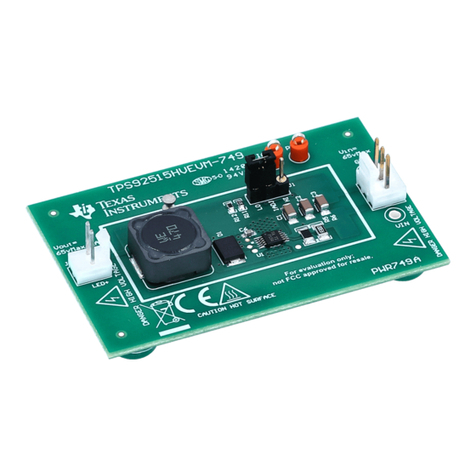
Texas Instruments
Texas Instruments TPS92515HVEVM-749 user guide
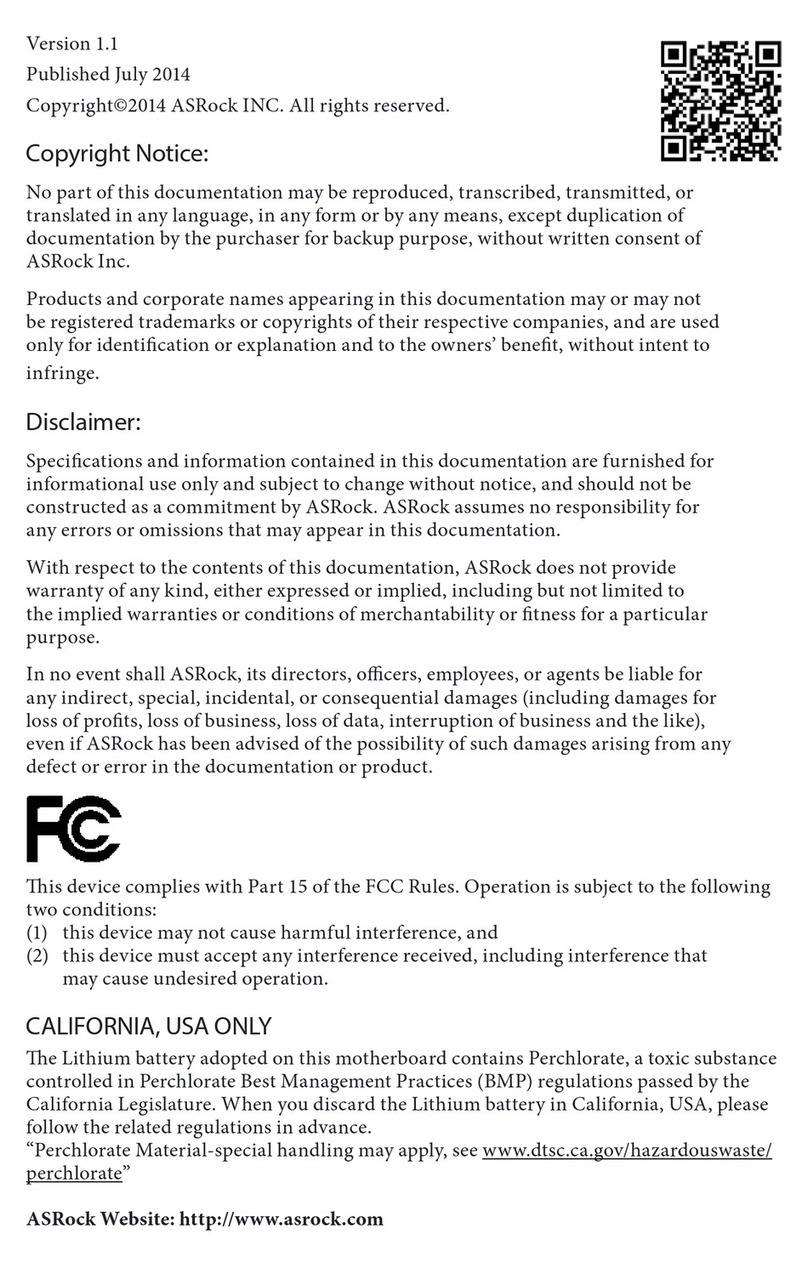
ASROCK
ASROCK H97M Anniversary user manual
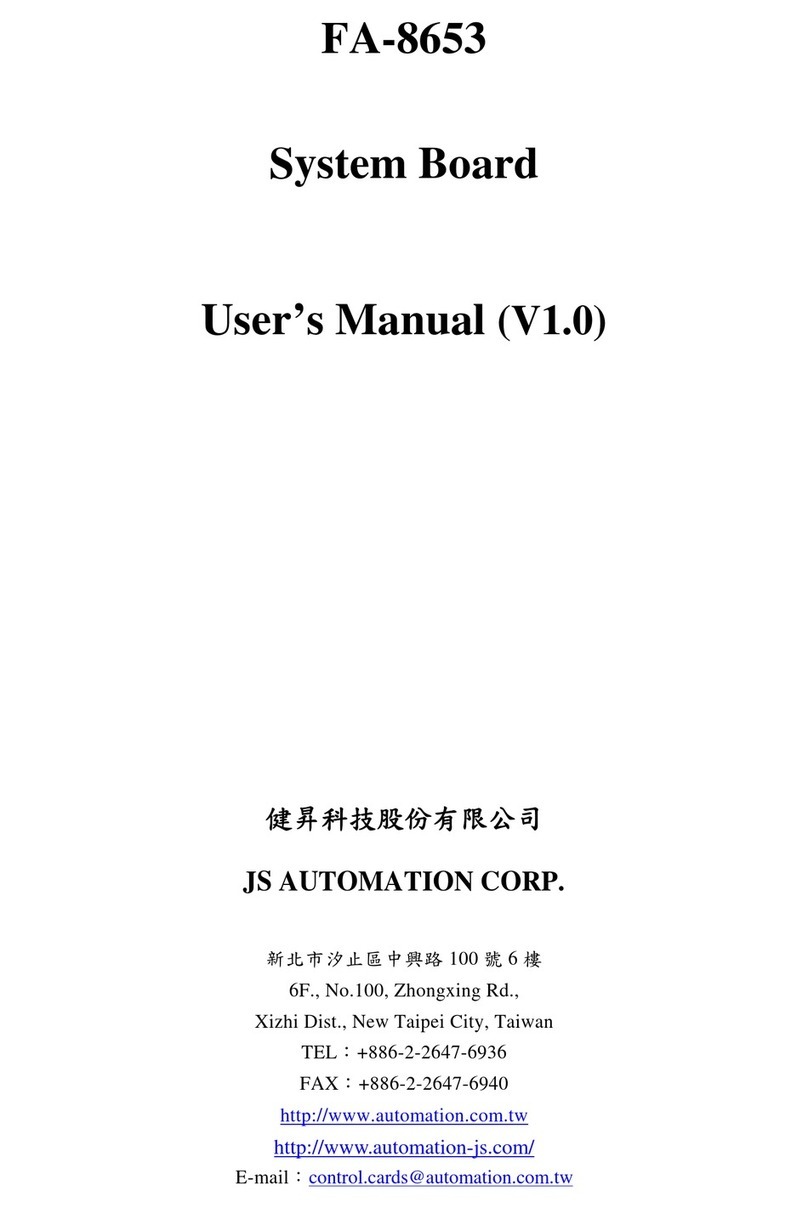
JS Automation Corp
JS Automation Corp FA-8653 user manual
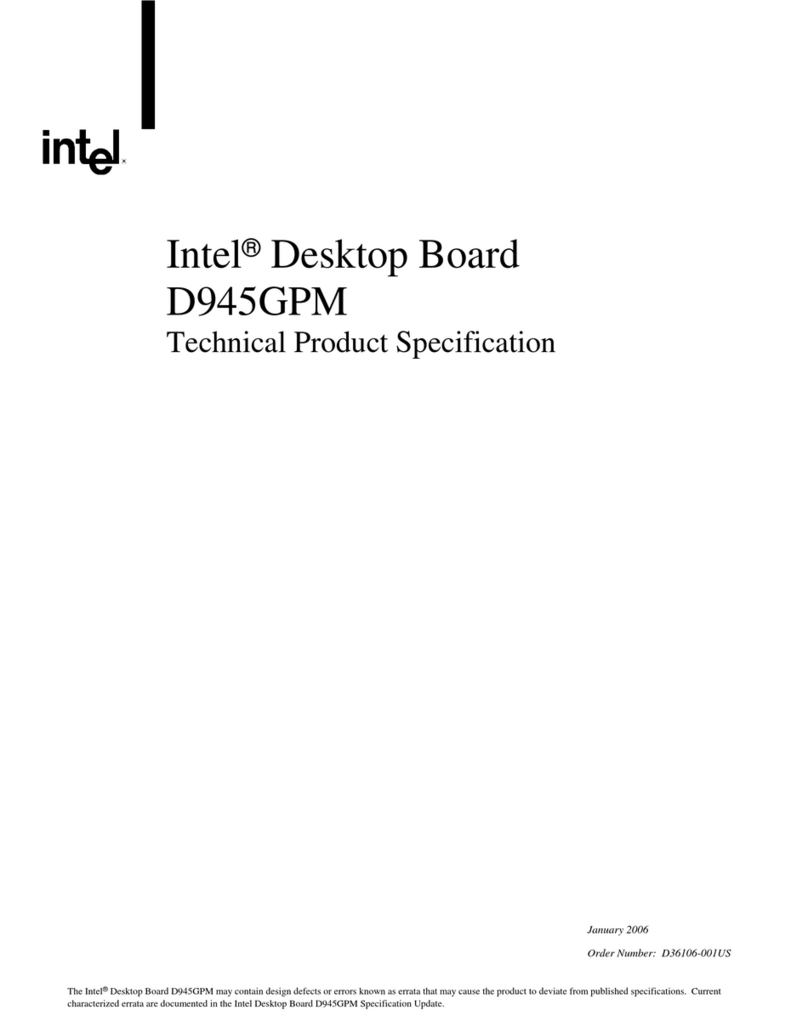
Intel
Intel BLKD945GPMLKR Technical product specification
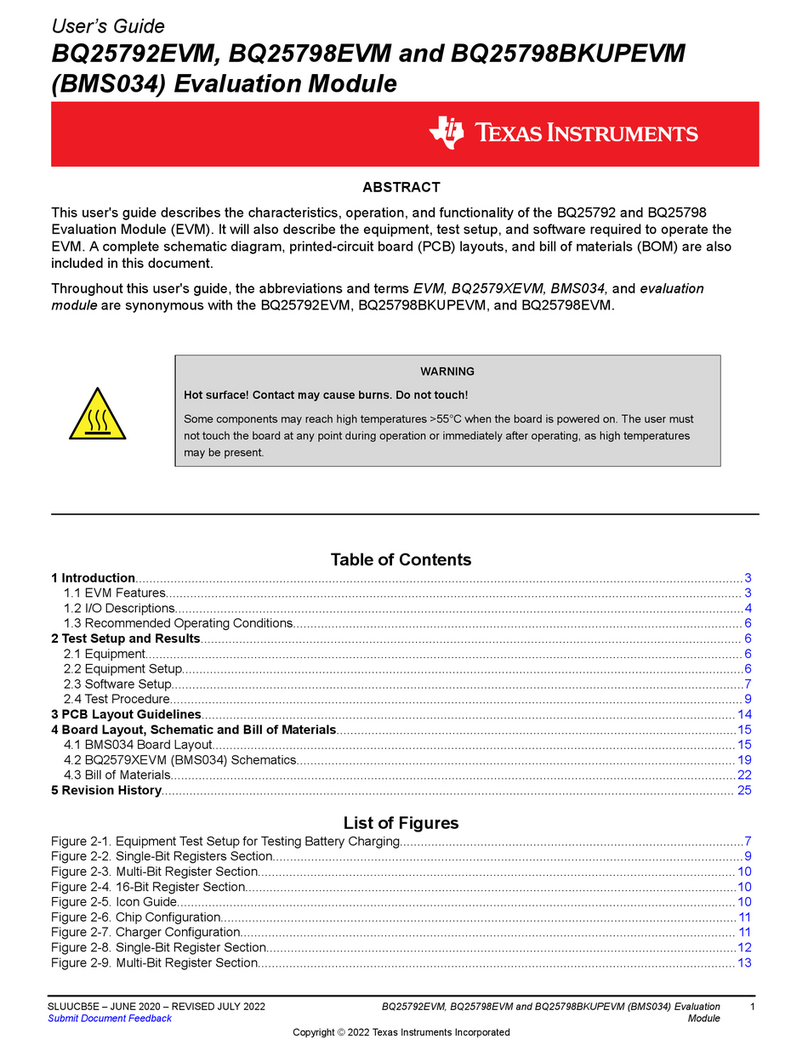
Texas Instruments
Texas Instruments BQ25792EVM user guide
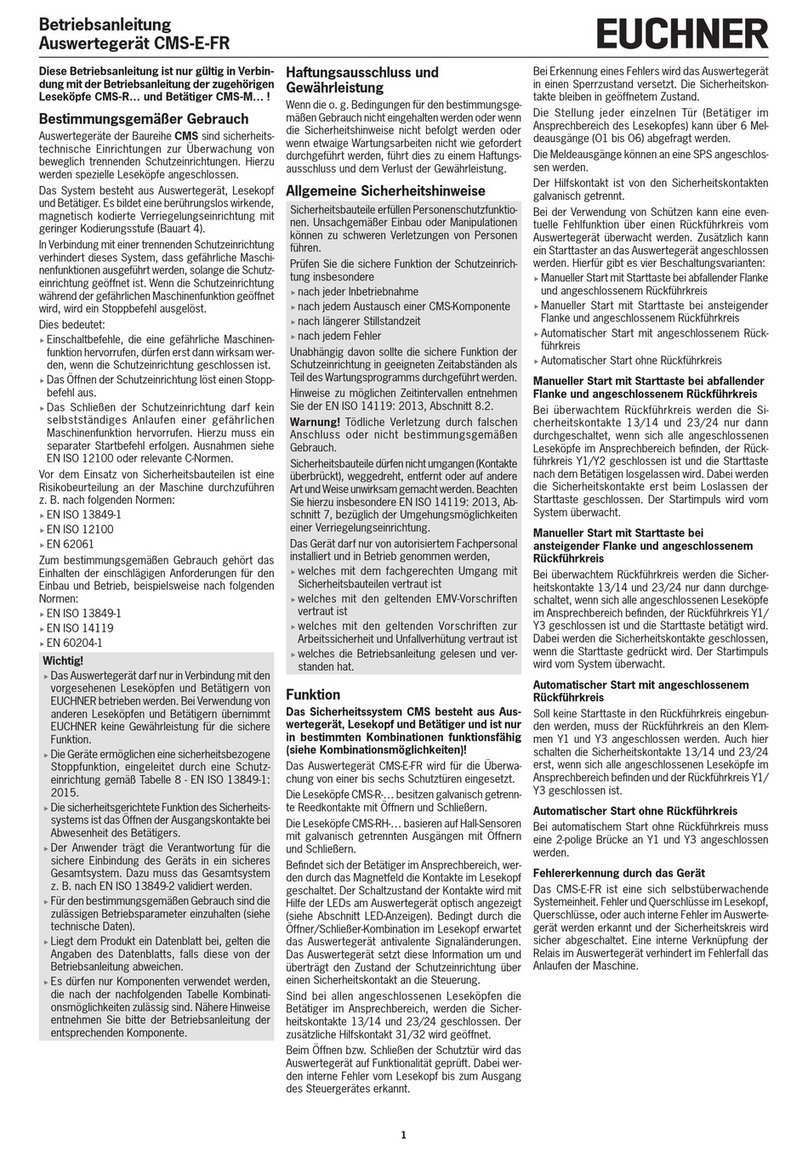
EUCHNER
EUCHNER CMS Series operating instructions
